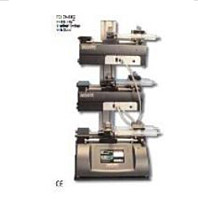Transvascular delivery of small interfering RNA to the centr
互联网
1444
http://img.dxycdn.com/trademd/upload/asset/meeting/2010/07/05/1278288013.pdf
A Mammalian microRNA Expression Atlas Based on Small RNA Library Sequencing
MicroRNAs (miRNAs) are small noncoding regulatory RNAs that reduce stability and/or translation of fully or partially sequence-complementary target mRNAs. In order to identify miRNAs and to assess their expression patterns, we sequenced over 250 small RNA libraries from 26 different organ systems and cell types of human and rodents that were enriched in neuronal as well as normal and malignant hematopoietic cells and tissues. We present expression profiles derived from clone count data and provide computational tools for their analysis. Unexpectedly, a relatively small set of miRNAs, many of which are ubiquitously expressed, account for most of the differences in miRNA profiles between cell lineages and tissues. This broad survey also provides detailed and accurate information about mature sequences, precursors, genome locations, maturation processes, inferred transcriptional units, and conservation patterns. We also propose a subclassification scheme for miRNAs for assisting future experimental and computational functional analyses.
http://img.dxycdn.com/trademd/upload/asset/meeting/2010/07/05/1278288014.pdf
Functional Demarcation of Active and Silent Chromatin Domains in Human HOX Loci by Noncoding RNAs
Noncoding RNAs (ncRNA) participate in epigenetic regulation but are poorly understood. Here we characterize the transcriptional landscape of the four human HOX loci at five base pair resolution in 11 anatomic sites and identify 231 HOX ncRNAs that extend known transcribed regions by more than 30 kilobases. HOX ncRNAs are spatially expressed along developmental axes and possess unique sequence motifs, and their expression demarcates broad chromosomal domains of differential histone methylation and RNA polymerase accessibility. We identified a 2.2 kilobase ncRNA residing in the HOXC locus, termed HOTAIR, which represses transcription in trans across 40 kilobases of the HOXD locus. HOTAIR interacts with Polycomb Repressive Complex 2 (PRC2) and is required for PRC2 occupancy and histone H3 lysine-27 trimethylation of HOXD locus. Thus, transcription of ncRNA may demarcate chromosomal domains of gene silencing at a distance; these results have broad implications for gene regulation in development and disease states.
The Mirtron Pathway Generates microRNA-Class Regulatory RNAs in Drosophila
Katsutomo Okamura,1 Joshua W. Hagen,1 Hong Duan,1 David M. Tyler,1 and Eric C. Lai1,
1 Memorial Sloan-Kettering Cancer Center, Department of Developmental Biology, 1275 York Ave, Box 252, New York, NY 10021, USA
Corresponding author
Eric C. Lai
laie@mskcc.org
Summary
The canonical microRNA (miRNA) pathway converts primary hairpin precursor transcripts into ∼22 nucleotide regulatory RNAs via consecutive cleavages by two RNase III enzymes, Drosha and Dicer. In this study, we characterize Drosophila small RNAs that derive from short intronic hairpins termed “mirtrons.” Their nuclear biogenesis appears to bypass Drosha cleavage, which is essential for miRNA biogenesis. Instead, mirtron hairpins are defined by the action of the splicing machinery and lariat-debranching enzyme, which yield pre-miRNA-like hairpins. The mirtron pathway merges with the canonical miRNA pathway during hairpin export by Exportin-5, and both types of hairpins are subsequently processed by Dicer-1/loqs. This generates small RNAs that can repress perfectly matched and seed-matched targets, and we provide evidence that they function, at least in part, via the RNA-induced silencing complex effector Ago1. These findings reveal that mirtrons are an alternate source of miRNA-type regulatory RNAs.
Molecular Basis for Target RNA Recognition and Cleavage by Human RISC
Stefan Ludwig Ameres,1 Javier Martinez,2, and Renée Schroeder1,
1 Max F. Perutz Laboratories, University of Vienna, Dr.-Bohr-Gasse 9/5, A-1030 Vienna, Austria
2 Institute of Molecular Biotechnology of the Austrian Academy of Sciences, IMBA, Dr.-Bohr-Gasse 3-5, A-1030 Vienna, Austria
Corresponding author
Javier Martinez
javier.martinez@imba.oeaw.ac.at
Corresponding author
Renée Schroeder
renee.schroeder@univie.ac.at
Summary
The RNA-Induced Silencing Complex (RISC) is a ribonucleoprotein particle composed of a single-stranded short interfering RNA (siRNA) and an endonucleolytically active Argonaute protein, capable of cleaving mRNAs complementary to the siRNA. The mechanism by which RISC cleaves a target RNA is well understood, however it remains enigmatic how RISC finds its target RNA. Here, we show, both in vitro and in vivo, that the accessibility of the target site correlates directly with the efficiency of cleavage, demonstrating that RISC is unable to unfold structured RNA. In the course of target recognition, RISC transiently contacts single-stranded RNA nonspecifically and promotes siRNA-target RNA annealing. Furthermore, the 5′ part of the siRNA within RISC creates a thermodynamic threshold that determines the stable association of RISC and the target RNA. We therefore provide mechanistic insights by revealing features of RISC and target RNAs that are crucial to achieve efficiency and specificity in RNA interference.









